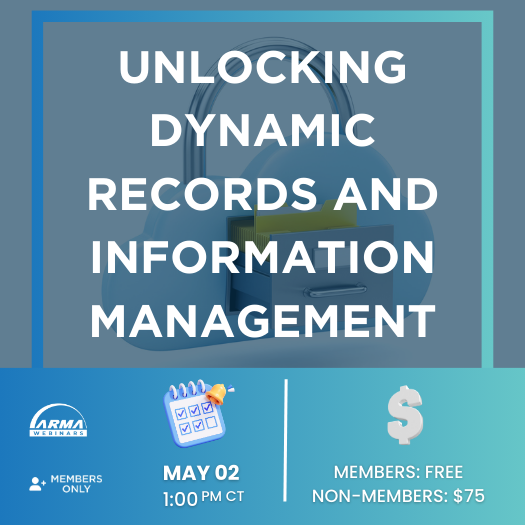Unlocking Dynamic Records and Information Management

Records and Information Management (RIM) is a business component vital to organizational success, yet it is rarely an organization’s top priority. Underpinning RIM practices at an organizational level is imperative to meeting legal requirements for government agencies and businesses in highly regulated industries.
Are you doing your annual file plan reviews? If yes, you are in great shape, right? Have you considered that organizations re-organize, information systems become obsolete, others get decommissioned, and regulations change? An annual file plan review alone will never account for all factors affecting your RIM program. Dynamic file plans can help organizations mitigate risk and increase findability.
Annual file plan reviews are snapshots in time at best, and over time, offices will develop their unique file plan structure. Dynamic file plans, in contrast, get updated as an environment changes so everyone is working with the latest known records series at any given time.
Where do the details of the records series in a file plan come from? That information comes from a thorough RIM inventory. To fully utilize and benefit from a dynamic file plan, the inventory must be dynamic as well. Every time a new system is set up or an old system is removed, the dynamic inventory and file plan must be updated. And this process must be part of your Information Governance plan.
How do you get started with dynamic inventories and file plans?
Dynamic Records and Information Inventory
The function of a records inventory is to identify and quantify all records created and managed by an organization. The inventory process gathers information about organizational records including description, series, format, date range, volume, location, and other pertinent data. Requirements for data captured can vary depending on organizational and governmental requirements and the goals of the inventory.
The aim of this process is not to document each record or folder but to identify each series and system. An incomplete and static inventory puts the organization at an elevated risk of missing or losing records.
Benefits of Dynamic Records Inventories
A complete and dynamically updated records inventory supports Information Governance by:
- reinforcing the management and control of records;
- improving risk management; and
- providing the framework for disaster recovery and business continuity.
Advantages of a dynamic records inventory include:
- supporting file plan development;
- determining record ownership;
- identifying record formats;
- assisting in responses to FOIA (Freedom of Information Act) requests, litigation holds, and data calls;
- identifying essential records for COOP (Continuity of Operations Planning);
- identifying records series that contain CUI (Controlled, Unclassified Information) and other sensitive or classified information; and
- detecting gaps in the RIM program’s management of records.
Dynamic records inventories also provide other benefits, including:
- providing a quick reference for all office staff showing all record types, retentions, and locations;
- identifying information ROT (redundant, obsolete, and trivial information);
- increasing management awareness of the RIM program and its needs; and
- justifying new or improved RIM system implementations.
How to Make an Inventory Dynamic
Creating a static inventory, even when comprehensive, only gives you a snapshot of your information environment at that moment. As the organization changes, the inventory must change with it. The inventory becomes dynamic when the data is hosted in a single place and when entries are updated regularly as a part of RIM operations.
Dynamic File Plans
A file plan is the key to a successful RIM program. File plans are office quick references that bring together:
- record types and locations from the dynamic inventory;
- organization-specific records schedules;
- other records schedules (e.g., the General Records Schedules or GRS for Federal agencies); and
- disposition authorities and instructions.
Regardless of the organization’s size, the inventory enables the creation of file plans that:
- cover all records and non-record materials, regardless of format or type;
- contain precise descriptions and straightforward disposition instructions; and
- can be updated regularly with the most current information.
Dynamic File Plans Provide ERM Requirements
When the design and implementation of IT systems to manage electronic records takes place, an accurate, complete, and up-to-date file plan provides the business requirements for configuring electronic records management solutions. These requirements include:
- record types;
- record locations;
- record disposition authorities;
- record disposition instructions;
- record owner information;
- records considered vital for business continuity; and
- which records require specific sensitivity markings (e.g., Personally Identifiable Information or Classified Information).
Dynamic File Plans Support Business Operations
During daily business operations, staff can refer to their dynamic office file plan to determine where records are stored and how to access them. This provides multiple business benefits, including:
- keeping records and information in their proper places;
- making FOIA requests, litigation holds, and data calls possible and timely;
- enabling more accurate audits; and
- mitigating risks associated with information ROT and access controls.
RIM System Lifecycle Governance
Information governance should always be a part of technology governance that manages the full lifecycle of information systems. From system design to decommissioning, each technology phase has related records and information management steps to adhere to.
RIM System Requirements
A dynamic inventory of records and information plus dynamic file plans for each office provide the business requirements for RIM system design. Solution architects use those details for capacity planning, access controls, and solution configuration. In the case of records migration, the inventory and file plans provide the “as-is” current state. As solution architects design the “to-be” future state of records locations, the current state is mapped to the new future state for any updates or migrations.
RIM System Implementation
As a new system is implemented, the file plans and inventory get updated to reflect the new future state of record locations. The records management features like tagging and disposition get configured.
RIM System Operations and Maintenance
During ongoing operations and maintenance (O&M) of the RIM system, any changes to the organization (e.g., reorganization or changes in file locations) must trigger updates to the dynamic file plans and inventory. This is typically a manual process, so it must be part of the RIM system lifecycle governance.
RIM System Decommissioning
When IT systems are decommissioned, any records that remain in those systems that are not due for disposition must be migrated to a new location. This can be a new system or a file repository. There the records will remain until they are due for disposition—or until migrated to a new home.
Unlocking Records and Information Management
Records inventories and file plans must be living documents. These dynamic references provide the key to unlocking records management that is beneficial to the business, manageable by IT and RIM staff, and compliant with rules and regulations.
WANT MORE?
Join the authors of this article, Kimberly Johnson and Kevin Parker for an in-depth webinar!


